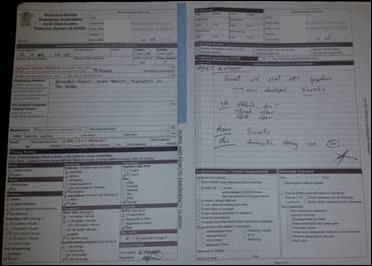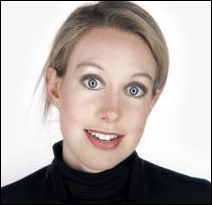There was a fair amount of buzz around my recent Curbside Consult on Theranos and its CEO, Elizabeth Holmes. Most of the comments and emails agreed with the need to question the company and its approach.
Thanks for putting a little reality into the mix. Like many in the healthcare field, I’ve been shocked at the money and attention being given to them. A couple of facts: the actual blood draw is a fairly involved and still painful procedure involving a “trained pricker” who prepares the finger for a few minutes with warm towels before sticking you to get the blood out. Personally I find finger sticks more painful than traditional blood draws. Sites still need trained people and it still takes 5-15 minutes per patient. Not very efficient. As for timing, the results don’t come back immediately and I believe it takes 15, 30, or more minutes. Most patients will be long gone anyway, so how is that much different from sending to a lab and getting them back the next day? I’m not sure “point of care” labs are hugely valuable for the typical primary care physician as the results are not immediate, and even if they were, they would only make sense if the patient got labs before the visit.
The reader goes on to agree that the industry is ripe for disruption, but that we need a couple of evolutions first. We need non-invasive testing that can be done almost instantly, as well as tests that are so cheap every patient will be able to come to the office to have them done immediately before seeing the physician. Maybe they’ll be able to do them at home or on a regular basis. He thinks maybe Theranos will evolve to that or maybe some quicker, cheaper company will come along. Another possibility is computerized algorithms that clarify what needs to be ordered and how to understand the results and explain them to patients.
There were also anecdotal stories about the risk of ordering labs without a clear indication.
I am a medical technologist, moving over to IT after having spent over a decade in the reference lab industry. I agree with your statements regarding interpretation of test results. My pregnancies were after age 35 and I chose to have an amniocentesis. A physician inadvertently ordered an AFP test during my second pregnancy. I didn’t know it was ordered, but found out it was elevated after a negative amnio. If I had received the results without the context of the amnio, it would have led to a great amount of stress. I fully support technology to lower costs in our healthcare system and consumer-friendly strategies to expand access and experience for patients as purchasers, but frankly don’t get the buzz around Theranos. Coordination around the right test for the patient at the right time with the right engagement of the patient makes sense. If the patient can get the order fulfilled easily and at a low cost with communication to their care team, than I am interested.
I have also been on the receiving end of tests ordered without my knowledge. Even as a physician, the results were stressful because there wasn’t a clear indication and I was confused as to what the ordering physician suspected. We’ve come a long way from the paternalistic “doctor knows best” days and I fully agree tests should be ordered with patient understanding and consent.
Additionally, physicians should explain why they’re ordering a test and what they hope to do with the results. In addition to justifying the medical necessity, this can get the patient thinking about the potential outcomes and what we might do with the information we get back. Several wise medical school professors beat the fact into my head that you should never order a test unless you’re ready to do something with the result. Unfortunately, I see a lot of tests ordered for no good reason. Some of these orders are influenced by our reimbursement system, which makes it easier and cheaper to order a bundle of tests than the individual tests that one actually needs. Medicare is guilty of supporting, this but I don’t think it’s ever going to change.
Some readers took issue with my assessment:
Traditionally, physicians have purposely kept patients in the dark in regards to what their lab tests mean. Even today, physicians routinely send “normal cards” to their patients without any explanation as to what the real values are or how to interpret. As healthcare requires increased patient engagement and increased participation in their care, it is imperative that all providers either teach or provide educational materials to start the educational process on what lab tests mean. That would be to understand normal variants, normal abnormal for the patient, etc.
I wholeheartedly agree. Most of the major health organizations in my area did away with “normal cards” for patients more than a decade ago, along with the antiquated notion of “no news is good news.” Our patients have been getting copies of their labs since 2008 or 2009 and most of the time they have physician annotations, unless the labs result on a weekend when the office is closed, in which case they should receive a communication on Monday. At my former employer, physician bonuses helped drive this behavior.
It sounds like this reader is also advocating that we all have a role in promoting health literacy. Dr. Wu commented on this topic, saying,
Health literacy is, as you may agree, embedded in the archaic public health concept of health promotion, which is still rooted in a pre-Internet, paternalistic medical model approach… Perhaps Ms. Holmes’s analogy is ironically correct — a weapon can be used for good (crime prevention) or bad, and how it is used, intent, and training are variables. Giving patients unfettered access to their medical data without context, training in a usable format, accompanied by an actionable plan is like handing a loaded weapon to a random person on the street. Oh yeah, we allow that.
I disagree that the concept of health promotion is archaic or paternalistic. Although it may not apply to all specialties, most family physicians who have trained in the last three decades have been schooled in health promotion as a shared interest between the patient and their care team. Health literacy is an essential part of health promotion and should be all of our responsibilities, whether we’re part of the public health infrastructure or not. As I mentioned above, physicians that order tests without explaining the risks and benefits to a patient are part of the problem.
Reader Long Time, First Time also disagrees:
Is this what passes for critical thinking in the doctor’s lounge? I doubt Theranos or Ms. Holmes has any more obligation to educate patients than your profession does. After centuries of privilege, your profession seems to take little accountability for the ignorance of your “real world patients,” as you like to call us sheep. You seem to think like the clerical elites that one resisted translating the Bible from Latin into the vernacular. In fact, I bet some of these same arguments are used in Saudi Arabia to keep women from driving cars. First they must understand fuel injection before they can drive… So in order to be acceptable, Elizabeth Holmes must first succeed where your professional has failed. I will posit that your professional elite never tried to educate us. This is a false and unattainable standard you are applying to Theranos. The Pot has once again called the Kettle black. I do not know if Elizabeth Holmes is the next PT Barnum of the next Steve Jobs. I do doubt she has any obligation to educate me, either in a moral or legal sense.
I didn’t say she had an obligation to educate patients, rather my hope that she would champion health literacy so that the average person could truly be empowered to take charge of his or her own health. Theranos and Elizabeth Holmes are receiving a tremendous amount of attention these days and could use that to the further advantage of patients across the country. I also hoped she’d find greater connection with the people she’s trying to serve, as I agree with many that her isolation isn’t good for her (or the company) in the long term.
I take issue with your point about making people understand fuel injection before they can drive. Keep in mind we don’t just let anyone drive in this country either – one has to be of a certain age and has to have passed both a written and skills test to do so legally. They may not need to understand fuel injection, but they do need to know the difference between the gas and the brake so that no one gets hurt.
Although I know that many physicians don’t have the time or the skills to truly engage with their patients, there are tens of thousands of us that do so on a regular basis. We do take it personally when our patients have difficulty understanding their health issues, and if we can’t get the job done, we’re not afraid to leverage other members of the care team. I certainly don’t have “centuries of privilege” behind me and was trained in several programs that kept the patient at the center of the care team.
There’s no litmus test that requires Theranos to atone for the sins of other professions, but one would hope they could use the spotlight currently shining on them to do more to help people understand exactly what it is they’re offering and how it could be of benefit. I do, however, think there should be a litmus test for companies that sell products that could be potentially harmful. If we have to put a disclaimer on a set of lawn darts, then we should probably have some protections around patients ordering tests whose results could lead to harm. Most physicians who have had to work up something like a false positive CEA (cancer antigen) test would probably have stories to share about the harm something like that can do and the unneeded fear, pain, and costs associated.
A couple of other readers made similar points that I agree with. From Not From Monterey:
Honestly, and this isn’t a cop-out, I believe that both you and the Theranos lady are correct. It is right to have people (or put differently, consumers) be allowed to buy tests on their own and it is also correct that many, many people in our fair nation would have no idea how to interpret the results of those tests. I think Elizabeth Holmes’s target customers are not the 50+ percent of our nation that are working poor or lower middle class. She’s targeting the young and well-educated who are doing pretty well but would love to get more information about their health. I know plenty of people who are not smart enough to understand the basics of lab test results, and that number of people might at times even include myself. But I also know lots of very smart people who can use Google, compare information across authoritative sites, and ask for advice. The second group is the bunch that Holmes will be targeting. I can’t pretend that this direct model, taking physicians out of the loop, won’t create confusion or misinformation. But it might also help some people. Some people.
I think you’re spot on. As a physician, though, I am morally obligated to serve all types of patients, not just those with the resources or education to manage tests on their own (and I’ve seen plenty of really smart people, including physicians, get in trouble managing things beyond their expertise). I’m happy to support greater engagement to those patients with the desire to be engaged whether they have the financial or educational resources to do so.
I’ll close with one reader’s personal Theranos story from Engaged Patient:
Just read your article on Theranos. I use to be in awe of this upstart who went up against Quest and Labcorp. But that impression changed when I got my own test done there. I have a severe family history of diabetes and had a wake-up call with a hemoglobin A1c of 6.0. I became an avid runner and ate well for three years. August 2015 was my next turn to see what improvements I brought to my health. Theranos did a complete venous draw (traditional test tube) on me, not the much-advertised finger prick. The result came back 6.0 and my PCP advised getting it done with a local reference lab. Their result was 5.4. If three years of sincere lifestyle changes had not moved my A1c lower, I was contemplating medication in the near future.
My issue with Theranos is that they don’t make it explicit to patients that not all their tests are FDA certified. They get undue press attention for the one-drop capillary draw – lots of marketing done for that. But the truth is that they, too require venous blood in huge amounts. How the heck does FDA/CLIA let unverified tests be out there for public consumption? I find Theranos to be dishonest and deceptive. I think we (health IT enthusiasts) are sometimes so deep in our MU/HIE/EHR world that these small, dangerous twists in the mass market go unnoticed. I shudder to think what would happen if a non-health-IT person would use Theranos to make health decisions.
I’m not the expert on laboratory regulation except where it is involved in how results are ordered and rendered in EHRs, so I’ll have to rely on readers to comment on the latter points. But the example brings up another wrinkle, which is that sometimes it’s important to make sure serial tests are being done by reference labs using the same or at least comparable methodologies. Different reference ranges can also cloud results even for tests that are supposedly “standardized.” I once counseled a patient who was in tears about his lab results, which were essentially identical. However, one facility reported them in nanograms (10) and the other in picograms (10,000) making it appear to be a dramatic change.
I don’t claim to have all the answers. If the comments are any reflection, none of us really do. The only constant is change and it will be interesting to look back at Theranos in three, five, or 10 years and see what they accomplished.
What do you want to accomplish in 10 years? Email me.

Email Dr. Jayne.

















Teens will certainly find a way to use their social media apps of choice. I'm not in favor of the…